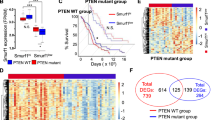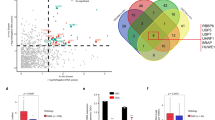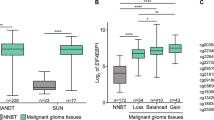Abstract
Overexpression of Rictor has been demonstrated to result in increased mechanistic target of rapamycin C2 (mTORC2) nucleation and activity leading to tumor growth and increased invasive characteristics in glioblastoma multiforme (GBM). However, the mechanisms regulating Rictor expression in these tumors is not clearly understood. In this report, we demonstrate that Rictor is regulated at the level of mRNA translation via heat-shock transcription factor 1 (HSF1)-induced HuR activity. HuR is shown to directly bind the 3′ untranslated region of the Rictor transcript and enhance translational efficiency. Moreover, we demonstrate that mTORC2/AKT signaling activates HSF1 resulting in a feed-forward cascade in which continued mTORC2 activity is able to drive Rictor expression. RNAi-mediated blockade of AKT, HSF1 or HuR is sufficient to downregulate Rictor and inhibit GBM growth and invasive characteristics in vitro and suppress xenograft growth in mice. Modulation of AKT or HSF1 activity via the ectopic expression of mutant alleles support the ability of AKT to activate HSF1 and demonstrate continued HSF1/HuR/Rictor signaling in the context of AKT knockdown. We further show that constitutive overexpression of HuR is able to maintain Rictor expression under conditions of AKT or HSF1 loss. The expression of these components is also examined in patient GBM samples and correlative associations between the relative expression of these factors support the presence of these signaling relationships in GBM. These data support a role for a feed-forward loop mechanism by which mTORC2 activity stimulates Rictor translational efficiency via an AKT/HSF1/HuR signaling cascade resulting in enhanced mTORC2 activity in these tumors.
This is a preview of subscription content, access via your institution
Access options
Subscribe to this journal
Receive 50 print issues and online access
$259.00 per year
only $5.18 per issue
Buy this article
- Purchase on Springer Link
- Instant access to full article PDF
Prices may be subject to local taxes which are calculated during checkout







Similar content being viewed by others
References
Laplante M, Sabatini DM . mTOR signaling in growth control and disease. Cell 2012; 149: 274–293.
Wu SH, Bi JF, Cloughesy T, Cavenee WK, Mischel PS . Emerging function of mTORC2 as a core regulator in glioblastoma: metabolic reprogramming and drug resistance. Cancer Biol Med 2014; 11: 255–263.
Cornu M, Albert V, Hall MN . mTOR in aging, metabolism, and cancer. Curr Opin Genet Dev 2013; 23: 53–62.
Oh WJ, Jacinto E . mTOR complex 2 signaling and functions. Cell Cycle 2011; 10: 2305–2316.
Oh WJ, Wu CC, Kim SJ, Facchinetti V, Julien LA, Finlan M et al. mTORC2 can associate with ribosomes to promote cotranslational phosphorylation and stability of nascent Akt polypeptide. EMBO J 2010; 29: 3939–3951.
Zinzalla V, Stracka D, Oppliger W, Hall MN . Activation of mTORC2 by association with the ribosome. Cell 2011; 144: 757–768.
Sarbassov DD, Guertin DA, Ali SM, Sabatini DM . Phosphorylation and regulation of Akt/PKB by the rictor-mTOR complex. Science 2005; 307: 1098–1101.
Tanaka K, Babic I, Nathanson D, Akhavan D, Guo D, Gini B et al. Oncogenic EGFR signaling activates an mTORC2-NF-kappaB pathway that promotes chemotherapy resistance. Cancer Discov 2011; 1: 524–538.
Bhattacharya K, Maiti S, Mandal C . PTEN negatively regulates mTORC2 formation and signaling in grade IV glioma via Rictor hyperphosphorylation at Thr1135 and direct the mode of action of an mTORC1/2 inhibitor. Oncogenesis 2016; 5: e227.
Guertin DA, Stevens DM, Saitoh M, Kinkel S, Crosby K, Sheen JH et al. mTOR complex 2 is required for the development of prostate cancer induced by Pten loss in mice. Cancer Cell 2009; 15: 148–159.
Read RD, Fenton TR, Gomez GG, Wykosky J, Vandenberg SR, Babic I et al. A kinome-wide RNAi screen in Drosophila Glia reveals that the RIO kinases mediate cell proliferation and survival through TORC2-Akt signaling in glioblastoma. PLoS Genet 2013; 9: e1003253.
Bashir T, Cloninger C, Artinian N, Anderson L, Bernath A, Holmes B et al. Conditional astroglial Rictor overexpression induces malignant glioma in mice. PLoS One 2012; 7: e47741.
Sarbassov DD, Ali SM, Kim DH, Guertin DA, Latek RR, Erdjument-Bromage H et al. Rictor, a novel binding partner of mTOR, defines a rapamycin-insensitive and raptor-independent pathway that regulates the cytoskeleton. Curr Biol 2004; 14: 1296–1302.
Cheng H, Zou Y, Ross JS, Wang K, Liu X, Halmos B et al. RICTOR amplification defines a novel subset of patients with lung cancer who may benefit from treatment with mTORC1/2 inhibitors. Cancer Discov 2015; 5: 1262–1270.
Driscoll DR, Karim SA, Sano M, Gay DM, Jacob W, Yu J et al. mTORC2 signaling drives the development and progression of pancreatic cancer. Cancer Res 2016; 76: 6911–6923.
Masri J, Bernath A, Martin J, Jo OD, Vartanian R, Funk A et al. mTORC2 activity is elevated in gliomas and promotes growth and cell motility via overexpression of rictor. Cancer Res 2007; 67: 11712–11720.
Gibault L, Ferreira C, Perot G, Audebourg A, Chibon F, Bonnin S et al. From PTEN loss of expression to RICTOR role in smooth muscle differentiation: complex involvement of the mTOR pathway in leiomyosarcomas and pleomorphic sarcomas. Mod Pathol 2012; 25: 197–211.
Chen CC, Jeon SM, Bhaskar PT, Nogueira V, Sundararajan D, Tonic I et al. FoxOs inhibit mTORC1 and activate Akt by inducing the expression of Sestrin3 and Rictor. Dev Cell 2010; 18: 592–604.
Koo J, Wu X, Mao Z, Khuri FR, Sun SY . Rictor undergoes glycogen synthase kinase 3 (GSK3)-dependent, FBXW7-mediated ubiquitination and proteasomal degradation. J Biol Chem 2015; 290: 14120–14129.
Yasuda K, Takahashi M, Mori N . Mdm20 modulates actin remodeling through the mTORC2 pathway via its effect on rictor expression. PLoS One 2015; 10: e0142943.
Lopez de Silanes I, Zhan M, Lal A, Yang X, Gorospe M . Identification of a target RNA motif for RNA-binding protein HuR. Proc Natl Acad Sci USA 2004; 101: 2987–2992.
Tenenbaum SA, Lager PJ, Carson CC, Keene JD . Ribonomics: identifying mRNA subsets in mRNP complexes using antibodies to RNA-binding proteins and genomic arrays. Methods 2002; 26: 191–198.
Srikantan S, Gorospe M . HuR function in disease. Front Biosci 2012; 17: 189–205.
Carpenter RL, Paw I, Dewhirst MW, Lo HW . Akt phosphorylates and activates HSF-1 independent of heat shock, leading to Slug overexpression and epithelial-mesenchymal transition (EMT) of HER2-overexpressing breast cancer cells. Oncogene 2015; 34: 546–557.
Chou SD, Murshid A, Eguchi T, Gong J, Calderwood SK . HSF1 regulation of beta-catenin in mammary cancer cells through control of HuR/elavL1 expression. Oncogene 2015; 34: 2178–2188.
Tandon M, Chen Z, Pratap J . Runx2 activates PI3K/Akt signaling via mTORC2 regulation in invasive breast cancer cells. Breast Cancer Res 2014; 16: R16.
Leach MD, Farrer RA, Tan K, Miao Z, Walker LA, Cuomo CA et al. Hsf1 and Hsp90 orchestrate temperature-dependent global transcriptional remodelling and chromatin architecture in Candida albicans. Nat Commun 2016; 7: 11704.
Mendillo ML, Santagata S, Koeva M, Bell GW, Hu R, Tamimi RM et al. HSF1 drives a transcriptional program distinct from heat shock to support highly malignant human cancers. Cell 2012; 150: 549–562.
Wang B, Jie Z, Joo D, Ordureau A, Liu P, Gan W et al. TRAF2 and OTUD7B govern a ubiquitin-dependent switch that regulates mTORC2 signalling. Nature 2017; 545: 365–369.
Masui K, Shibata N, Cavenee WK, Mischel PS . mTORC2 activity in brain cancer: extracellular nutrients are required to maintain oncogenic signaling. BioEssays 2016; 38: 839–844.
Barreau C, Paillard L, Osborne HB . AU-rich elements and associated factors: are there unifying principles? Nucleic Acids Res 2005; 33: 7138–7150.
Jacobson A, Peltz SW . Interrelationships of the pathways of mRNA decay and translation in eukaryotic cells. Annu Rev Biochem 1996; 65: 693–739.
Gabai VL, Meng L, Kim G, Mills TA, Benjamin IJ, Sherman MY . Heat shock transcription factor Hsf1 is involved in tumor progression via regulation of hypoxia-inducible factor 1 and RNA-binding protein HuR. Mol Cell Biol 2012; 32: 929–940.
Riemenschneider MJ, Betensky RA, Pasedag SM, Louis DN . AKT activation in human glioblastomas enhances proliferation via TSC2 and S6 kinase signaling. Cancer Res 2006; 66: 5618–5623.
Dai C, Santagata S, Tang Z, Shi J, Cao J, Kwon H et al. Loss of tumor suppressor NF1 activates HSF1 to promote carcinogenesis. J Clin Invest 2012; 122: 3742–3754.
Nabors LB, Gillespie GY, Harkins L, King PH . HuR, a RNA stability factor, is expressed in malignant brain tumors and binds to adenine- and uridine-rich elements within the 3' untranslated regions of cytokine and angiogenic factor mRNAs. Cancer Res 2001; 61: 2154–2161.
Hsu JH, Shi Y, Hu L, Fisher M, Franke TF, Lichtenstein A . Role of the AKT kinase in expansion of multiple myeloma clones: effects on cytokine-dependent proliferative and survival responses. Oncogene 2002; 21: 1391–1400.
Jo OD, Martin J, Bernath A, Masri J, Lichtenstein A, Gera J . Heterogeneous nuclear ribonucleoprotein A1 regulates cyclin D1 and c-myc internal ribosome entry site function through Akt signaling. J Biol Chem 2008; 283: 23274–23287.
Zuo J, Rungger D, Voellmy R . Multiple layers of regulation of human heat shock transcription factor 1. Mol Cell Biol 1995; 15: 4319–4330.
Cloninger C, Bernath A, Bashir T, Holmes B, Artinian N, Ruegg T et al. Inhibition of SAPK2/p38 enhances sensitivity to mTORC1 inhibition by blocking IRES-mediated translation initiation in glioblastoma. Mol Cancer Ther 2011; 10: 2244–2256.
Vartanian R, Masri J, Martin J, Cloninger C, Holmes B, Artinian N et al. AP-1 regulates cyclin D1 and c-MYC transcription in an AKT-dependent manner in response to mTOR inhibition: role of AIP4/Itch-mediated JUNB degradation. Mol Cancer Res 2011; 9: 115–130.
Holmes B, Lee J, Landon KA, Benavides-Serrato A, Bashir T, Jung ME et al. Mechanistic target of rapamycin (mTOR) inhibition synergizes with reduced internal ribosome entry site (IRES)-mediated translation of cyclin D1 and c-MYC mRNAs to treat glioblastoma. J Biol Chem 2016; 291: 14146–14159.
Acknowledgements
We thank Dr Eugene Kandel, Dr Jacob Fleischmann, Dr Norimoto Yanagawa, Dr Sanjai Sharma and Dr Paul Mischel for cell lines and reagents. We also thank Dr Alan Lichtenstein for comments on the manuscript and Jheralyn Martin and Janine Masri for technical assistance. This work was supported, in whole or in part, by VA MERIT I01BX002665 and NIH R01CA109312 grants.
Author contributions
Conceived and designed the experiments: BH, RNN, JG. Performed the experiments: BH, AB-S, RSF, KAL, TB. Analyzed the data: BH, RNN, JG. Wrote the paper: BH, RNN, JG.
Author information
Authors and Affiliations
Corresponding author
Ethics declarations
Competing interests
The authors declare no conflict of interest.
Additional information
Supplementary Information accompanies this paper on the Oncogene website
Supplementary information
Rights and permissions
About this article
Cite this article
Holmes, B., Benavides-Serrato, A., Freeman, R. et al. mTORC2/AKT/HSF1/HuR constitute a feed-forward loop regulating Rictor expression and tumor growth in glioblastoma. Oncogene 37, 732–743 (2018). https://doi.org/10.1038/onc.2017.360
Received:
Revised:
Accepted:
Published:
Issue Date:
DOI: https://doi.org/10.1038/onc.2017.360
This article is cited by
-
The ELAVL3/MYCN positive feedback loop provides a therapeutic target for neuroendocrine prostate cancer
Nature Communications (2023)
-
PLOD1 acts as a tumor promoter in glioma via activation of the HSF1 signaling pathway
Molecular and Cellular Biochemistry (2022)
-
Build-UPS and break-downs: metabolism impacts on proteostasis and aging
Cell Death & Differentiation (2021)
-
The plasticity of mRNA translation during cancer progression and therapy resistance
Nature Reviews Cancer (2021)
-
mTOR-Rictor-EGFR axis in oncogenesis and diagnosis of glioblastoma multiforme
Molecular Biology Reports (2021)



